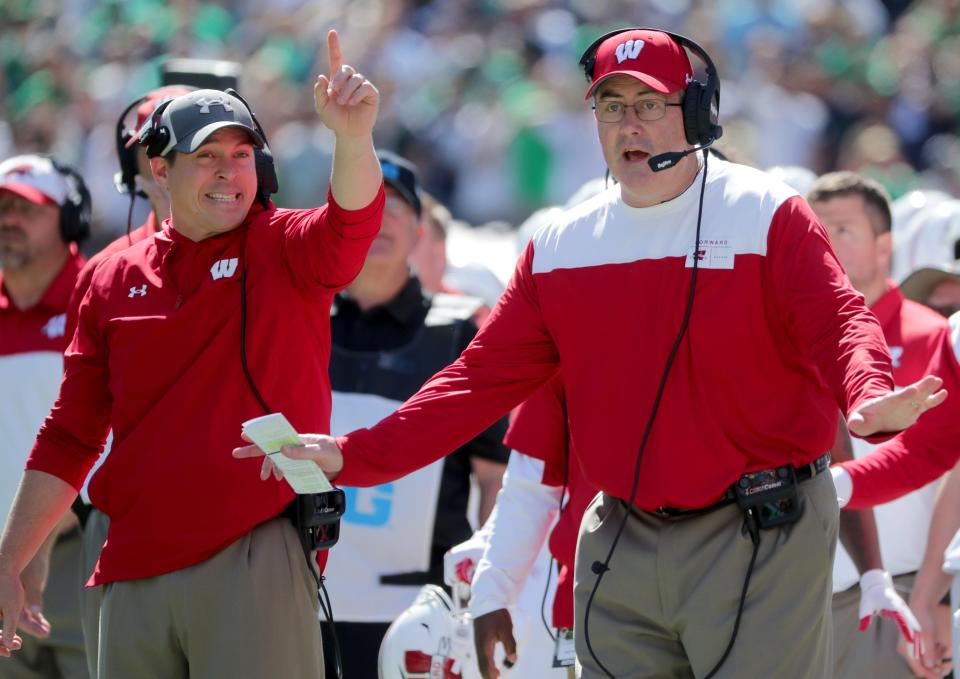Wisconsin's firing of Paul Chryst shows colleges will pay big to make changes | Opinion
Paul Chryst, the Wisconsin coach who was fired Sunday night, won 72 percent of his games.
It didn’t matter.
As recently as 2019, he had the Badgers in the Rose Bowl.
It didn’t matter.
Just a year ago, almost to the day, it became public that he had earned a $1 million annual raise and would be owed a buyout just shy of $20 million if he were fired in 2022.
It didn’t matter.
At the first sign of real trouble for Wisconsin’s program in a long time, the school looked at where it was, where things were headed under Chryst and what its other options might be and told him thank you for your service. And the crazy part is, given the current environment of college football, they might not have even been wrong to do it.
Compared with the $95 million guaranteed contracts Michigan State handed to Mel Tucker and Texas A&M invested in Jimbo Fisher — deals that look like really bad business just a year later — Wisconsin got off cheaply. We can argue about Chryst’s record or whether he quote-unquote deserved to get fired, but this is the new normal.
For the amount of money schools are paying, they want year after year results. And it does not seem like there’s a limit to what they’ll spend to get rid of a coach they no longer want.
This was supposed to be one of the quieter years in the coaching market, and yet Sunday marked the fourth consecutive week with at least one power conference coach getting fired. In some cases, like Nebraska with Scott Frost or Herm Edwards at Arizona State, the deed should have been done last December. In other cases, like with Geoff Collins at Georgia Tech and Karl Dorrell at Colorado, the hole had gotten so deep that there was no way to climb out.
CFB WEEK 5 WINNERS, LOSERS: Alabama shows resolve, Wisconsin embarrassed at home
MISERY INDEX: Brent Venables failing in first season as head coach at Oklahoma
SPORTS NEWSLETTER: Get the latest news and analysis in your inbox

Chryst is by far the most jarring midseason change, even though it wasn’t difficult to see after Saturday’s 34-10 loss to Illinois that it might eventually head in this direction.
The surprise is perhaps as much about Wisconsin, an athletic department that has had remarkable coaching longevity in both men’s football and basketball. Wisconsin isn’t the type of school that rides emotional roller coasters with coaches or chases after the shiny objects. Instead, its entire ethos screams steadiness and consistency. Not so long ago you could have envisioned Chryst, a former Wisconsin quarterback, coaching there for another 15 or 20 years.
At minimum, you’d have expected a coach with two top-10 finishes and three Big Ten West division titles in his first five years to get a chance to turn things around. After all, Wisconsin won nine games merely a year ago. While there were some ugly moments this year in the Badgers’ 2-3 start, we aren’t talking about a sustained nosedive.
But a couple dynamics could have been in play in this decision.
First and foremost, it gives Wisconsin a chance to take a long look at Jim Leonhard, the former Badgers star and NFL defensive back who was elevated to interim head coach. Leonhard has been courted by the Green Bay Packers among others for defensive coordinator jobs and was expected to be a head coaching candidate in college this year.
Second, making the change now puts Wisconsin on even footing with Nebraska as the most attractive early openings. That could be significant since the candidate pools at those two schools could look similar. Lance Leipold, whose Kansas team off to a 5-0 start, has been frequently mentioned as a likely candidate at Nebraska where he once worked as an assistant. But Leipold has even more ties to the state of Wisconsin, where he grew up and led Wisconsin-Whitewater to six Div. 3 national titles.
However, Wisconsin ultimately arrived at the decision to change coaches, that’s the culture now in college sports: Better to be one year too early than one year too late.
The last decade has seen two SEC coaches fired a mere two seasons removed from winning a national championship in Gene Chizik and Ed Orgeron. And the amount of slack coaches are given is only going to get worse in the transfer portal era, where an entirely new team can essentially be recruited every year.
Impatience is an old reality in college sports, which is why coaches and agents fight for these massive guaranteed contracts that schools usually come to regret. But the buyouts becoming bigger has not served as much of a deterrent for churning from one coach to the next.
Every time we think there’s an upper limit to the salaries and the buyouts, we’re proven wrong. It wasn’t $10 million, it wasn’t $20 million, and it probably won’t be $50 million if that’s what it takes.
The ravenous appetite to fix a football mistake in college sports has not changed, which means the economics are simple. As long as schools continue to show there's no limit to what they'll pay, the cost is going to only go up.
This article originally appeared on USA TODAY: College football's pricey buyouts not stopping coach firings

 Yahoo Movies
Yahoo Movies 
